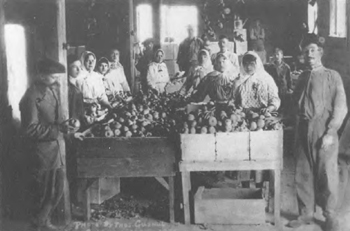News & Events More |
Associated Growers in OperationThe Associated, as it was generally known, was, almost from its inception, on the defensive. The high-powered membership and organization campaign had promised great results, and many growers signed up who were not "natural cooperators", not men enlisted by the philosophical conviction that cooperation was the proper and inevitable form of organization. Rather they were individualists interested in the promised high returns. These men looked with a critical eye at the organization and were encouraged in this by the few remaining independent shippers and by all those who, for reasons of political or economic philosophy, opposed cooperation. Therefore, it was unfortunate for the Associated that the B.C. apple crop of 1923 was 200,000 boxes larger than that of 1922, and coincided with one of unprecedented size throughout North America. Associated Growers managed to avoid recourse to dreaded consignment, but was unable to control supply to the market because of competition from other producing areas and local supplies it did not control. The eventual results were unsatisfactory. Better results could have been obtained had the control of the crop been more complete. The percentage offered in competition was sufficiently large to threaten the stability of prices and at times made it most difficult to maintain our principle of f.o.b. sales. Price competition resulted in many reductions with consequent losses to growers, and this should have been unnecessary.  It was cold comfort to the growers who had received less than their production cost to be told that things would have been even worse without Associated Growers. Some growers then decided against the cooperative experiment and left through loopholes in their contracts. In the 1924 crop year, the tonnage handled declined from 85 per cent to 75 per cent. Prices for the 1924 crop were better, and the decline in membership slowed, but was never totally arrested. Each year the portion of the crop controlled by Associated Growers was slightly smaller, slipping to 70 per cent in 1928, and falling off more rapidly after the five-year contract ended. Only 65 per cent of the 1929 crop was handled by Associated Growers, and by 1933 only 40 per cent. Contact Us Hours: 9am - 4pm weekdays. t: 250-762-5226 |

